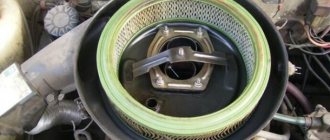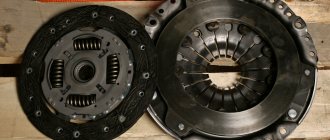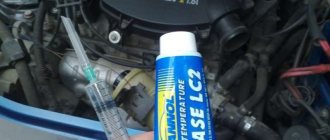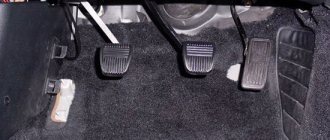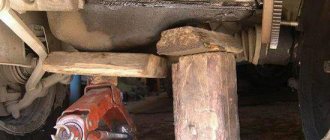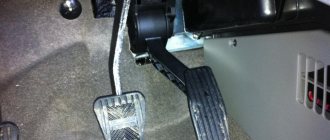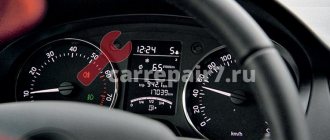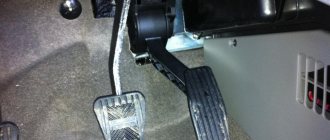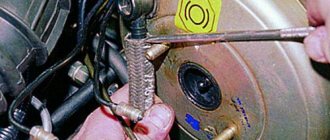Eliminating the creaking of the clutch pedal on a VAZ 2110. — logbook of the 2003 Lada 2110 PhiX on DRIVE2
Hi all!
We continue to mock the car, and this time we will make the clutch pedal softer and quieter. I think many owners of tens and other front-wheel drive VAZs have noticed that the clutch pedal becomes tighter over time and a squeak appears. There may be several reasons for this, and I want to talk about the fight against one of them. In search of the cause of the tight pedal and creaking, I took the easy way and first tried to lubricate the cable and boss, which naturally did not bring any effect. Having eliminated the cable, I moved on. The reason for the tight pedal and squeaking is the friction that occurs between the bushings and the axis of the clutch release fork. This happens because over time the lubricant loses its properties. The main source of the problem is the lower bushing, because it is metal, and as you know, metal slides without lubrication with great reluctance, with the risk of scuffing, i.e. with excess friction. The upper bushing is plastic and even without lubrication the axle glides well in it.
This is what these bushings look like.
Thus, the main task is to lubricate the lower bushing. Ideally, you would have to remove the box, replace both bushings with new ones and fill them with fresh grease. But since we have enough more important things to do, throwing away the box in vain was not part of my plans. I decided to implement an improvement that I learned about a long time ago, but as always, I never got around to it.
The essence of the modification is to drill a hole in the plastic bushing of the clutch fork axis, and then lubricate both bushings through this hole.
It all sounds very simple, and in reality the same thing happens. Next in order: We remove the air filter box so that it does not interfere.
We find this very bushing. And it is located at the checkpoint, strictly under the thermostat.
We drill a hole in it with a diameter of about three millimeters so that the nose of the syringe can fit through. By the way, in order to reach the bushing, you will need a fairly long drill. You can probably try to drill a short one, but the wiring harness and CO pipes will get in the way. You need to drill until the drill rests on the fork axis.
Then we fill the syringe with oil, I used transmission oil, and slowly pour it into the hole. The oil will not go away quickly, because... The bushing fits tightly to the axle.
To speed up the process, you can slightly lift the bushing (as far as the latches will allow) by prying it around the perimeter with a screwdriver.
You need quite a lot of oil so that it flows along the axis and properly lubricates the lower bushing. I poured about thirty cubes, there is no need to be afraid of overdoing it, the excess will simply flow out.
You can plug the hole using a screw.
If you suddenly need to lubricate the bushings again, this can be done by simply unscrewing the screw.
After the procedure has been completed, we get behind the wheel, squeeze the clutch and almost have time to get upset, because nothing has changed. But We don’t give up, we press the clutch five or ten times again, and on the next press the pedal falls down with less effort and without the nasty squeak.
Conclusions: After lubrication, I finally got rid of the annoying squeaking noise and the clutch pedal became much softer. The feeling can be compared to replacing the clutch with a new one.
PEACE to everyone, like, share the post with friends, this is another modification for the VAZ from the MUST HAVE category!
Price: 50 ₽ Mileage: 179,800 km
How to renew?
The main factor influencing clutch life is driving style. To save the disk, you need to avoid high loads. Do not start driving at high speeds (with slipping) and do not overload the vehicle itself. The last factor also applies to those who like to drive with a trailer. Remember that every kilogram from the trailer loads the gearbox and clutch components. Do not tow vehicles that exceed your curb weight. These factors directly affect the life of the clutch disc. Using a careful driving style, you can increase the capabilities of this element to 150 thousand kilometers or more. In sports driving mode and other loads, even the highest quality VAZ 2110 clutch, the price of which is quite high, will not last even 40 thousand kilometers.
It's easy and interesting to communicate here. Join us!
the clutch drive cable is stretched out, the linings are worn out, the clutch fork is bent or broken.
The disk is worn out and needs replacement! Soon there will be no traveling at all!
Khan the clutch really needs to be changed. the disc will wear down to the rivets, it will be fun to fly onto the clutch + flywheel... If there is no money, you can play with the cable and adjust the pedal so that it is slightly lower than the brake. there are nuts on the cable under the hood. In short, if you play with Murzilka with pictures, you will read it and you will understand, good luck, my friend. next time don't be too proud. you will have time for the next world.
Hard clutch pedal
If you own a car with an automatic transmission, then this article may not seem interesting to you, because now we will talk about an indispensable part for vehicles with a manual transmission. Of course, we mean the clutch pedal, which serves as the main link between the driver’s desire and the “obedience” of the car. To engage or disengage the clutch, a certain force must be applied to the pedal, but if excessive loads are required from the driver, then this is a clear sign of the presence of some problems in the system.
Causes of a hard clutch pedal
Why do we sometimes have to encounter such a phenomenon as a “hard clutch pedal”? In fact, there are several most common reasons. Firstly, the pedal lever itself often jams or the cable gets jammed, and secondly, the source of such problems can be too much wear on the clutch fork bearing, which is why it also begins to move slowly. In some cases, a stiff clutch pedal is due to a blockage in the hydraulic system or wear on the release bearing.
Naturally, to restore the clutch pedal to normal operation, you will have to take a number of necessary actions, but first, let’s try to understand the various signs of various malfunctions. For example, if the stiffness of the clutch pedal is the result of wear on the fork bearing, then when you press the pedal you will hear some characteristic rumbling, indicating that the release bearing has already served its allotted time, and it is time to replace it with a new part.
The mechanisms produced today are designed to cover fairly long distances (more than 1,300 km), but the driver would do well to carry out regular diagnostics and timely elimination of emerging problems (including replacing broken parts). In those cases where the system is treated negligently and inattentively, the clutch pedal will last you at most 50,000 kilometers, and in large trucks problems can be caused by poor grinding in of new elements.
The problem of incomplete engagement of the mechanism should not be excluded from the possible causes of “hard clutch”. In such situations, when changing gear, the driver of the vehicle will hear a characteristic grinding noise. This is due to the inability of the driven disk to come off the pressure plate normally. To fix this problem, it is best to immediately contact professionals.
Incomplete shutdown of the device also has its reasons. These include:
– incorrect adjustment of the cable;
– jamming of the driven disk;
– incorrect assembly of the system unit;
– severe wear of the switching mechanism.
The problem of a “hard” clutch pedal occurs in different cars, and hydraulically driven vehicles are no exception. If you are the owner of just such a car, then you should know that a tight clutch pedal can be explained by several reasons: a bent fork, coked splines of the input shaft along which the driven disk slides, contamination of the bushing along which the release bearing moves, as well as damage to the internal parts of a flexible hose of the hydraulic drive system. These are the most common explanations for the problem of a stiff pedal, but they are far from the only ones.
For example, on old hoses a piece of rubber may peel off, which will ultimately play the role of a kind of valve, so if you look for the reason without dismantling the gearbox, you can replace the flexible hose yourself and bleed the clutch, and if this does not help, then contact service specialists.
What to do if the clutch pedal is hard?
If the clutch pedal on your vehicle suddenly becomes tight, and the gears are switched with a certain effort (and it also happens that the speed does not turn on at all), first of all it is necessary to establish the exact cause of this phenomenon. It is likely that the clutch cable will need to be completely replaced and adjusted. This process has its own characteristics, and before installing a new element, it is necessary to lubricate it thoroughly with a special liquid. For this purpose, WD-40 is often used.
Causes of slipping and ways to eliminate them
Not in all cases you will necessarily have to buy a completely new clutch. Once, out of inexperience, I changed a unit, which turned out to be almost completely serviceable. In reality, it was just necessary to change one inexpensive component. But sometimes you have to learn from your mistakes.
From everything I have learned, I realized that determining the cause of clutch slipping plays a key role here. Your further actions directly depend on this.
- The clutches are worn out. Your actions depend on the degree of wear. When the distance between the working elements used is less than 0.2 mm, you can simply adjust the free play of the pedal. In case of severe wear, the driven disk and linings are replaced;
- Oil appeared on the linings. Oil on the friction linings may appear due to certain problems in the flywheel drainage or an excessive amount of lubricant in the box. The oil should be removed and the surface dried. Kerosene works well. After cleaning, go through with fine sandpaper;
- Damage to the integrity of the rubber components of the hydraulic drive. When they swell, the clutch very often begins to slip. Here you will have to remove both cylinders (worker and main), wash them with alcohol, replace the rubber elements and clean the expansion holes. Don't forget to bleed the clutch and the brakes themselves;
- Loss of elasticity of pressure springs. This problem occurs on old cars that have been in use for over 10 years. Elasticity decreases gradually, which causes the required level of pressure on the driven disk to drop. As a result, the clutch slips. The check is carried out by removing the clutch disc. If elasticity has decreased, they will have to be replaced.
There are cases when changing individual components or trying to restore their functionality is pointless. The wear or damage is so severe that repairs will only have a short-term effect. A better solution here would be to completely replace the clutch.
Subscribe, tell your friends about us and don’t forget to come to us again!
Watch this video on YouTube
The clutch pedal creaks on a VAZ-2110
Car: VAZ-2110. Asks: Dmitry Aksyonov. The essence of the question: the clutch pedal on the VAZ-2110 began to creak, what should I do?
Damn, bad again! The clutch pedal on the VAZ-2110 began to creak. At first it creaked quietly, but now it’s getting stronger. I looked there in the pedal assembly, tried to lubricate it, but I can’t find where. What to do if the pedal squeaks more and more?
Why does the clutch pedal on a VAZ-2110 squeak?
Experts note that the clutch pedal on the VAZ-2110 is not tight compared to other domestic cars. This is even noticeable when the lubricant on the rubbing parts of the squeezing force transmission dries out.
The following two tabs change content below.
Causes
In the diagram, red arrows indicate places where squeaking may occur due to lack of lubrication.
When you drive a car for a long time and do not have it inspected, this will cause the driver to feel discomfort when driving, for example, a creaking sound when pressing the clutch pedal.
- Typically, modification and elimination of such a problem is carried out by drilling a larger diameter hole on the shaft attaching the pedal to the body bracket. You can do this yourself.
- Before work, it is important to find a shaft of suitable diameter that will be placed in the socket.
- After installing the new shaft, you will need to drip 4-6 drops of oil onto it every day until it breaks in.
- The oil will get into the gap between the bushing and the bracket, which will prevent the pedal from squeaking when pressed.
Other possible sources of squeaking
conclusions
After such an event, the pedal will be squeezed easier. This does not require repairing the box. Such modifications can be made not only on the VAZ 2110, but also on other cars of new domestic models.
Video about lubrication of the clutch fork without disassembling the box
The clutch on the VAZ 2110 was changed two weeks ago. At first the clutch pedal was pressed softly, but now it became hard. They installed a new cable, what was the reason? And the most interesting thing is that the basket remained the same, so that’s not the reason
- Which side should I put the clutch disc on? – 3 answers
- Extraneous sound when starting VAZ 2110 - 3 answers
- Clutch housing VAZ 2110 – 2 answers
- What is the best clutch to install on a VAZ-2110? – 2 answers
- How to tighten the clutch basket of a VAZ 2110? – 2 answers
So what next? Tell us about how the clutch works. How does the car start, how do the gears change? There is also a clutch fork there. There is a release bearing there. And plus a clutch pedal in the cabin. In addition, something could also happen in 2 weeks (rust, warp, break, etc.).
Purpose
To understand where the release bearing is located, you need to understand the purpose and design of the clutch. The clutch and all its parts belong to the vehicle's transmission. It ensures the transmission of torque from the engine to the drive axle and wheels, and must be located between these parts of the machine
But an important condition for the location is accessibility in its control by the driver. Most often this is the clutch pedal, less often the lever near the steering wheel
Using the clutch mechanism, the driver periodically disconnects the engine from the transmission. This allows you to stop the car, change the gearbox, and change the driving dynamics.
The clutch pedal creaks on a VAZ-2110
Car: VAZ-2110. Asked by: Dmitry Aksenov. The essence of the question: the clutch pedal on the VAZ-2110 began to creak, what should I do?
Damn, bad again! The clutch pedal on the VAZ-2110 began to creak. At first it creaked quietly, but now it’s getting stronger. I looked there in the pedal assembly, tried to lubricate it, but I can’t find where. What to do if the pedal squeaks more and more?
Why does the clutch pedal on a VAZ-2110 squeak?
Experts note that the clutch pedal on the VAZ-2110 is not tight compared to other domestic cars. This is even noticeable when the lubricant on the rubbing parts of the squeezing force transmission dries out.
The following two tabs change content below.
All my life I have been surrounded by cars! First, in the village, already in the first grade, I was rushing around on a tractor through the fields, then there was JAVA, then a penny. Now I am a third-year student at the Polytechnic Faculty of Automotive Engineering. I work part-time as a car mechanic and help repair cars for all my friends.
Causes
In the diagram, red arrows indicate places where squeaking may occur due to lack of lubrication.
When you drive a car for a long time and do not have it inspected, this will cause the driver to feel discomfort when driving, for example, a creaking sound when pressing the clutch pedal.
- Typically, modification and elimination of such a problem is carried out by drilling a larger diameter hole on the shaft attaching the pedal to the body bracket. You can do this yourself.
- Before work, it is important to find a shaft of suitable diameter that will be placed in the socket.
- After installing the new shaft, you will need to drip 4-6 drops of oil onto it every day until it breaks in.
Other possible sources of squeaking
The “grandmother” on the bushing may creak.
The clutch cable holder can also be a source of squeaking noise.
Pin for fastening the clutch cable to the pedal.
Lubricating the brake pedal mounting pin.
Lubricate the clutch fork shaft through the side hole.
Lubricating the clutch fork axle through the hole in the plug.
Hydraulic failure
Some VAZ models have a hydraulically driven clutch. This system involves:
- line where the special liquid should be located;
- slave and master cylinders.
Here the base of the pedal is fixed to the piston rod of the latter. Pressing it squeezes out the liquid, and it goes into the working cylinder, which acts on the fork. Thus, the pedal on a VAZ can fail if the system loses its tightness. First of all, you need to see whether there is enough liquid left in the tank located in the engine compartment. Proceed like this:
- make up for its deficiency;
- monitor the stability of the level.
Hard clutch pedal
If you own a car with an automatic transmission, then this article may not seem interesting to you, because now we will talk about an indispensable part for vehicles with a manual transmission. Of course, we mean the clutch pedal, which serves as the main link between the driver’s desire and the “obedience” of the car. To engage or disengage the clutch, a certain force must be applied to the pedal, but if excessive loads are required from the driver, then this is a clear sign of the presence of some problems in the system.
Causes of a hard clutch pedal
Why do we sometimes have to encounter such a phenomenon as a “hard clutch pedal”? In fact, there are several most common reasons. Firstly, the pedal lever itself often jams or the cable gets jammed, and secondly, the source of such problems can be too much wear on the clutch fork bearing, which is why it also begins to move slowly. In some cases, a stiff clutch pedal is due to a blockage in the hydraulic system or wear on the release bearing.
Naturally, to restore the clutch pedal to normal operation, you will have to take a number of necessary actions, but first, let’s try to understand the various signs of various malfunctions. For example, if the stiffness of the clutch pedal is the result of wear on the fork bearing, then when you press the pedal you will hear some characteristic rumbling, indicating that the release bearing has already served its allotted time, and it is time to replace it with a new part.
The mechanisms produced today are designed to cover fairly long distances (more than 1,300 km), but the driver would do well to carry out regular diagnostics and timely elimination of emerging problems (including replacing broken parts). In those cases where the system is treated negligently and inattentively, the clutch pedal will last you at most 50,000 kilometers, and in large trucks problems can be caused by poor grinding in of new elements.
The problem of incomplete engagement of the mechanism should not be excluded from the possible causes of “hard clutch”. In such situations, when changing gear, the driver of the vehicle will hear a characteristic grinding noise. This is due to the inability of the driven disk to come off the pressure plate normally. To fix this problem, it is best to immediately contact professionals.
Incomplete shutdown of the device also has its reasons. These include:
– incorrect adjustment of the cable;
– jamming of the driven disk;
– incorrect assembly of the system unit;
– severe wear of the switching mechanism.
The problem of a “hard” clutch pedal occurs in different cars, and hydraulically driven vehicles are no exception. If you are the owner of just such a car, then you should know that a tight clutch pedal can be explained by several reasons: a bent fork, coked splines of the input shaft along which the driven disk slides, contamination of the bushing along which the release bearing moves, as well as damage to the internal parts of a flexible hose of the hydraulic drive system. These are the most common explanations for the problem of a stiff pedal, but they are far from the only ones.
For example, on old hoses a piece of rubber may peel off, which will ultimately play the role of a kind of valve, so if you look for the reason without dismantling the gearbox, you can replace the flexible hose yourself and bleed the clutch, and if this does not help, then contact service specialists.
What to do if the clutch pedal is hard?
If the clutch pedal on your vehicle suddenly becomes tight, and the gears are switched with a certain effort (and it also happens that the speed does not turn on at all), first of all it is necessary to establish the exact cause of this phenomenon. It is likely that the clutch cable will need to be completely replaced and adjusted. This process has its own characteristics, and before installing a new element, it is necessary to lubricate it thoroughly with a special liquid. For this purpose, WD-40 is often used.
In addition, often the clutch pedal simply cannot be depressed. This is often preceded by excessively light pressure or complete “failure.” Such breakdowns are often associated with improper adjustment of the cable or its breakage. In such cases, it would be useful to check the condition of the release bearing, which may be damaged, which is why it becomes difficult to press the pedal. You should also check the diaphragm spring located on the pressure plate for damage.
If you are used to repairing your vehicle yourself and are well familiar with the features of its design, then such a check can be performed independently, but in most cases, car owners prefer to seek help from service station specialists.
How to fix it?
The easiest way to “soften” the clutch pedal is to lubricate the release bearing guide and clutch fork support. Of course, this method will help fix the problem only if more serious malfunctions and component defects are excluded. To perform this task it is not at all necessary to dismantle the gearbox. Simply remove the cable from the fork, then the protective rubber, and then secure the fork so that it does not slip out of the support bearing. After completing these tasks, take a flashlight and see if the mechanism has enough lubrication.
If it is missing, then carefully clean the dirt with a wire and lubricate the part. Move the fork in different directions so that the lubricant is better distributed over the entire surface. Also, do not forget about the support located behind the fork; it must also be well lubricated. Of course, due to the limited engine compartment space, it is quite inconvenient to perform all of the above actions, but if desired, nothing is impossible. Therefore, be patient and confidently begin the task.
Subscribe to our feeds on Facebook, Vkontakte and Instagram: all the most interesting automotive events in one place.
Was this article helpful?Yes No
Deaeration of hydraulics
After repairing the cylinders or eliminating the leak that caused the pedal to fail, it is necessary to bleed the system to remove air from it.
You should hire a partner for the job. The procedure is as follows:
- the protective cap is removed from the fitting of the VAZ master cylinder;
- instead, a hose of a suitable cross-section is put on;
- the end of the latter is placed in a jar, into which a couple of glasses of brake fluid are first poured;
- then loosen the fitting a little and press the pedal a couple of times, and then leave it in the lower position;
- At the same time, monitor the liquid level in the tank;
- when the air stops coming out in the form of bubbles, the fitting is tightened and the pedal is released.
Why is the clutch on the VAZ 2110 tight?
Best site news
:: Author Message Val69
15 years on the forum
Added: 06 May 2004 08:03 The clutch pedal has become tight. What is the treatment? two months ago I lubricated the high pressure cable, it helped, but not for long. nm78
14 years on the forum
Added: 06 May 2004 10:01 Val69 wrote: The clutch pedal has become tight. What is the treatment? two months ago I lubricated the high pressure cable, it helped, but not for long. I had the same garbage at one time on nine. It was cured only by replacing the cable. Zlobniy DAg
13 years on the forum
Car: Hyundai Coupe 2002
Added: 06 May 2004 11:25 Val69 wrote: The clutch pedal has become tight. What is the treatment? two months ago I lubricated the high pressure cable, it helped, but not for long. Isn't this a sign of a dying clutch? Does he take it high? Dim Dimych
13 years on the forum
Added: 06 May 2004 11:38 Val69 wrote: The clutch pedal has become tight. What is the treatment? two months ago I lubricated the high pressure cable, it helped, but not for long. The clutch cable is definitely due for replacement. There was such a problem - until I changed it, it was not cured _________________ Well secured. The patient does not need anesthesia! NName
13 years on the forum
From: I come from Urals. Southern Urals
Added: 06 May 2004 12:21 maybe the cable - if somewhere the inner braid has already worn out - lubricant will not help here, replace it. but most often the cable is a consequence, not a cause. I encountered this myself - the clutch became tight - due to the release valve running without lubrication along the guide sleeve (when there was no lubrication there at all). then the cable broke (replaced), until the release assembly was replaced, the clutch remained tight. The metal of the bushing was worn on one side. You can try to lubricate the bushing where the release lever goes without removing the box, but it’s almost like “fucking a mouse in a hole” Victor P.
15 years on the forum
Symptoms of a problem
Repeated introduction of the friction mechanism causes operational wear of parts. Symptoms appear (Symptom from Greek - case, coincidence, sign - one separate sign, frequent manifestation of a disease, pathological condition or disorder of any vital process)
the following breakdowns.
- The clutch slips and slips. The connection between the engine and the checkpoint is lost (Checkpoint is a point designed to control passage (visit) and access to the territory of any facility)
. The friction surface of the driven disk has become abraded and contaminated. The clutch setup is rubbish. It requires disassembly, inspection, identification and elimination of defects, and replacement of basket parts. It is determined by the relationship between engine speed and vehicle speed. An increase in the first parameter should be accompanied by an increase in the second.
The reason for the imbalance is wear of parts, ingress of lubricant. The temperature of the unit increases, and a corresponding smell of burnt linings appears. If oil stains are detected, it is necessary to find the source of the leak, change the oil seals on the crankshaft and gearbox side. Remaining oil is washed off with turpentine, a rust removing liquid. The external appearance of surfaces and thickness are assessed. Worn, deformed, cracked discs must be replaced and centered.
- The clutch "drives". The motor is not completely disconnected from the transmission drive. The discs maintain light contact with the flywheel. Switching is accompanied by sharp sounds. Splines and gears are damaged, chips and burrs occur. An indirect sign is difficulty engaging first gear and reverse.
Verification method. Place the car on a horizontally level platform. Start the engine. Depress the left pedal. Turn on first speed. Without releasing your foot, the machine will try to move. Adjusting the clutch of the VAZ 2114 will help correct the situation.
- The pedal stroke has increased. The cable became slightly stretched during use. Determined in 2 ways. The most experienced driver directs attention to the dip of the foot in the direction of the floor of the cabin, the ankle joint straightens more. The relative position of the clutch and accelerator levers has changed. The operation of the node does not begin immediately after pressing. The most reliable method of control is measurement with a ruler or tape measure. The cable tension will need to be adjusted.
- Adjustment measures should complete repair work related to the box.
Why is the clutch on the VAZ 2110 tight?
here someone in my review wrote that after replacing the entire clutch, the pedal becomes weightless, apparently very light, but mine is very tight right now, so I was thinking of changing it, maybe something is faulty or has already worn out? Tell me what can affect the tightness of the clutch release? What might not be working correctly?
pws-nsk.ru Products for Martial Arts and Crossfit, tel.: 2-123-123
maybe change the fluid? what else besides e-liquid maybe, I was recently on a hundred, about a month ago, with the device they looked at all the liquids for replacement, everything was within the normal range, i.e. replacement is not coming soon they said
pws-nsk.ru Products for Martial Arts and Crossfit, tel.: 2-123-123
When all the components of the clutch are new - the petals of the basket are even, the basket is easy to push through. As the disc/basket/flywheel wears out, the basket becomes more humpbacked and it becomes more and more difficult to “break” it
Last edited by igor vm; 01/13/2012 at 20:55.
Professional repair of Subaru electric racks
What is the correct name for the return spring or what? does she have anything to do with it?
pws-nsk.ru Products for Martial Arts and Crossfit, tel.: 2-123-123
Message from 8eTeR
What is the correct name for the return spring or what? does she have anything to do with it?
Which is on the fork in the gallery - you can pull it into a string with your foot and you won’t feel it. It only moves the release fork away from the basket. By the way, another important point is that the release fork should slide easily along the box guide; the edges and steps will have an effect. Well, you need high-quality lubricant.
Professional repair of Subaru electric racks
nope, the pedal moves smoothly back and forth, without any jerks, smoothly up and down, I think the steering is normal, the pedal doesn’t stick anywhere, it throws it off well) it’s just tight, the leg actually sometimes gets tired of holding the pedal in a traffic jam, you have to hold it with your foot pedal, namely with your foot =))
pws-nsk.ru Products for Martial Arts and Crossfit, tel.: 2-123-123
Yes, it’s clear, especially in traffic jams. Most likely the disc is already thin. Well, take off the box and you will see what I’m talking about. After installing the new hitch, pay attention to how the petals are located on the basket - almost exactly...
Professional repair of Subaru electric racks
Message from 8eTeR
here someone in my review wrote that after replacing the entire clutch, the pedal becomes weightless, apparently very light, but mine is very tight right now, so I was thinking of changing it, maybe something is faulty or has already worn out? Tell me what can affect the tightness of the clutch release? What might not be working correctly?
If the year is 2005 and higher, then this is true, direct turbo squeezing is very difficult compared to reverse. It's good for your health, don't worry.
It's better to do it and regret it than not to do it and still regret it
I have a 2004 model, the turbo dore-restyle fluid and clutch are good, the squeezing is tight, in comparison let’s say a Lacetti or a Focus. So nothing has changed for a long time, I thought that’s how it should be until I read this topic.
Message from Mondeo
I have a 2004 model, the turbo dore-restyle fluid and clutch are good, the squeezing is tight, in comparison let’s say a Lacetti or a Focus. So nothing has changed for a long time, I thought that’s how it should be until I read this topic.
Tight means it’s suitable for replacing the clutch assembly, you don’t have to look at the mileage, it depends on the driving style. I had experience, a friend had an Impreza WRX 220pony, he was the second owner and the car was still under the dealer’s warranty, so they also compared its clutch with mine, mine was many times easier, even though the mileage was 125t.km. I changed everything in the Impreza assembly and everything turned around!
Forester EJ201 MTX2 01 Japan - yes Impreza EL154 SS 08 Euro - yes BRAT EA81 MTX2 89 Euro - yes
Well, I don’t know, everything is always new, and since 2005, with direct squeezing on all cars it was tighter than with the opposite one. I notice this now when I drive old cars.
It's better to do it and regret it than not to do it and still regret it
I had a slipping clutch, I changed the entire set, along with the flywheel, and the squeezing force felt the same on both the old one and the new one. So maybe it also depends on the kit itself.
Subaru Legacy MY08 EJ204
Hello everyone, guys, tell me, I have a legacy, born in 1995. I’ve had it for four years now. The clutch was tight once every half a year. I change the cables, they break; I didn’t do anything; but still this is not a way out
Today I tried where the clutch pedal straightened out the bend, it becomes easier (but I couldn’t straighten it, I didn’t have enough strength and was afraid to break it, and when I hold the clutch with my hand, it’s much easier to squeeze out.) where the clutch pedal is where the casing ends, that is, there is a bend in the cable when it comes out from the casing. and it got dark, I didn’t have time, I’ll repeat it tomorrow :)
Install hydraulics the next time you change the disc.
It's better to do it and regret it than not to do it and still regret it
Posted by anatoly1983
I had a slipping clutch, I changed the entire set, along with the flywheel, and the squeezing force felt the same on both the old one and the new one. So maybe it also depends on the kit itself.
Forester 2007 manual transmission purchased, Forester '2000 S/20 manual transmission given to dad, Impreza 2.0 '97 HX20S manual transmission sold.
There was such a problem as a “traffic jam” so “turn out the lights”, I pressed the pedal with my heel, I was thinking about selling the car. The clutch began to slip. I threw off the box and saw: the disk was in rags, the basket was some kind of Korean, the release NTN. With all this, according to the previous owner, the car covered 20 thousand km and I drove 20. I installed the basket and disk from EXEDY, the NTN roller. Put it back together, operating time 5 hours. My happiness knew no bounds, how soft it could be. BE-5 EJ-204.
Adjustment instructions
The Lada Priora is equipped with a clutch cable with a ratcheting mechanism. The cable is backlash-free and does not require adjustment, but manufacturers recommend this be done during every maintenance.
Clutch cable
To adjust the cable on the Lada Priora, you need to prepare a screwdriver and a ruler. The procedure then consists of the following steps:
- To perform work, you must open the hood.
Engine compartment of Lada Priora First, you should disconnect the mass air flow sensor and remove the air filter.
Engine compartment without air filter
- After this, a cable will be visible, at the end of which there is a plastic clip.
- Before adjustment, it is necessary to set the cable to its original position: overcoming the resistance of the spring, push the cable clamp forward until it stops in the direction of movement of the car.
- This clamp should be pulled towards you and the distance between it and the plug should be measured, it should be 27 mm.
We measure the distance using a ruler - The distance is adjusted by turning the tip counterclockwise. In this way, an increase in distance can be achieved.
- Twist the clamp until the distance is 27 mm. Accuracy is very important here.
- Now you can release the cable and place it in the fork.
- After completing the steps, you need to get behind the wheel and press the pedal three times until it stops.
- Then again you need to measure the distance, it must be exactly 27 mm, otherwise we adjust until the desired distance is achieved.
- Next, you should insert the tip into the groove of the mechanism fork and release it. Thanks to the spring, the tip driver clamp is installed without any gap.
- After adjusting the cable, you need to return everything to its place, start the engine and check the operation of the mechanism.
After adjustment, the clicks disappear and the clutch release pedal operates softer.
Clutch pedals
When the clutch pedal travel is large, the clutch is not completely disengaged, so it still comes into contact with the flywheel of the power unit. When the stroke is low, the driven disk does not turn on completely, which leads to slipping and loss of torque.
You should measure your pedal stroke if the following symptoms occur:
jerks appear when starting to move; noise and shock when shifting gears; the pedal gets stuck.
The symptoms described indicate that the mechanism requires adjustment. You can diagnose its operation on Priora yourself. To do this, start the engine, slowly release the PS and start moving. If, when the PS is released, the car immediately begins to move, this means that there is no free play. If the car does not budge even with the pedal fully released, then its travel exceeds the norm. The brake pedal should be at the same level as the brake pedal. In this case, its full stroke will be in the range of 125-135 mm. Fluctuations up to 160 mm are possible.
We measure the free play of the pedal
When making adjustments, loosen the first cable adjusting locknut located in the engine compartment on the bracket.
Locknuts for adjusting free play
By tightening the second locknut, the distance and stroke of the PS are adjusted. Thus, the desired result is achieved. After completing the procedure, the first locknut is tightened.
If you adjust so that the brake pedal is located above the brake pedal, then the clutch will barely leave the floor. If it is lower, it will set almost at the very end. If the PS is located too high, the basket wears out faster. The ideal option is that the brake and clutch pedals should be at the same level.
In order to extend the life of any mechanism, you should use it carefully. You should not constantly keep your foot on the PS; it is better to place it on the left on the floor. During each technical inspection of the Lada Priora, it is recommended to monitor the free movement of the PS and the clarity of gear shifting and, if necessary, make adjustments.
Reviews from car owners
If you look at the opinions of car owners about this component of the car, many note that it quite often creates problems. For example, some have to deal with tight pedal movement or the appearance of unpleasant crunching and clicking noises.
However, few people have to buy a complete clutch kit. Often a specific detail is enough. Therefore, most often it is enough to install a new cable or lubricate the jacket. Accordingly, even if this unit fails, repairs will not be as expensive as it might seem.
In general, car owners are satisfied with this car. It is inexpensive and does not require special care. If you do not use it in extreme conditions, then there should be no problems. It also performs well on difficult roads. Many note that modern foreign cars at the same cost have much worse characteristics.

